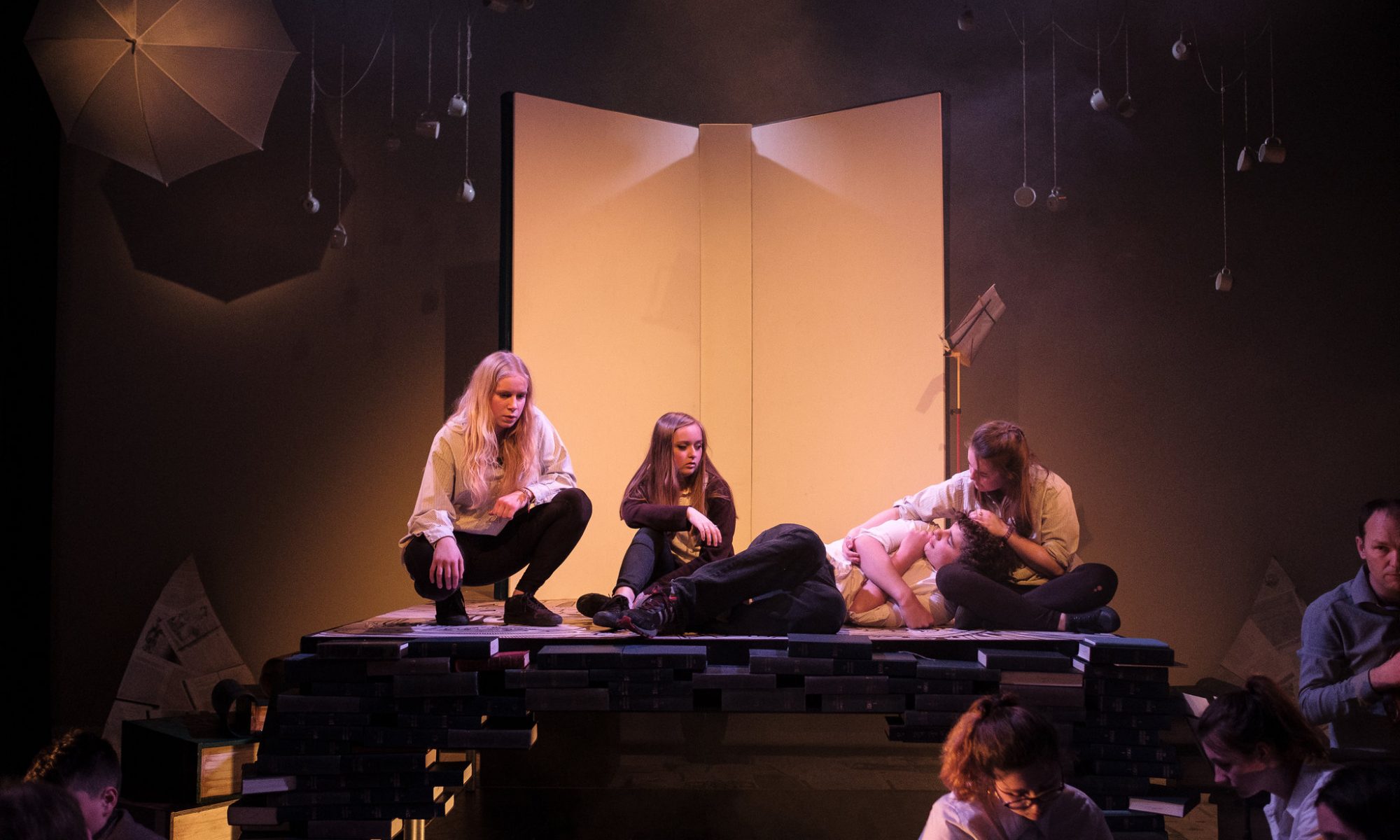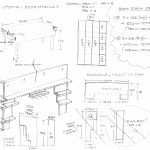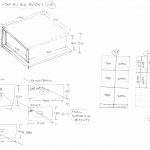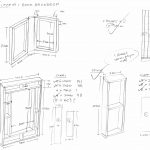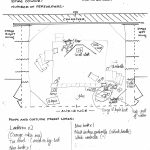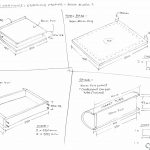The technical challenges of creating and recording Utopias
Nomi Everall, Design & Technical Director
Creation
Theatre making is in itself a particular act of utopia-seeking. More so than any other art form. It asks for democratic community collaboration within a world of specific and limited resources, in the creation of a perfect ‘world’ (both story-world and physical-world) with all the impossibilities that that implies. “Perfect” theatre is the successful fusion of the unique and specialist skills and visions of a huge number of individual collaborators (directors, writers, performers, choreographers, composers, visual & technical designers, technicians and stage-crew to name but a few), using the resources they have to the greatest effect, in one seamless, coherent act of storytelling. The more unified the vision of the creative team, the more enlightening, impactful, enjoyable and thoughtful a piece of theatre will be. Think for a moment what you lose if you turn the sound off when watching a film – it’s not only the spoken words – the narrative – you lose, but much more significantly, much of the atmosphere and many of the emotional prompts that help us understand the significance of what happens in the story. Little surprise then that it’s a goal rarely achieved and much sought after… There are so many elements, so many voices and visions, so many intentions which all need to be aligned to the same purpose. And that purpose may be, itself, hazy and indistinct to begin with.
Within “production” – the non-performance aspects of play-making – there might be an extraordinary number of people involved: set, costume and props designers and builders/makers, lighting and video designers, programmers and operators, composers, sound designers and engineers, a stage-manager, deputy stage-manager and assistant stage managers (stage crew) as a mere starting point. Even at a small-scale where fewer people are involved, they tend to cover multiple roles rather than any element of production disappearing completely.
With each iteration of Storming Utopia, the production teams have changed – we’ve gone from virtually no designer in the first instance to a design team of twelve in the second; we’ve had a crew of five 11-16 year olds with little or no theatre experience at the first Pegasus performance to technical support from just one experienced adult technician at our Worcester College garden performance, to a crew of five 13-17 year olds with much more technical training under their belts at the second stage Oxford performances and back to a two-person adult production team when we set off for Italy, to perform the show at the Cini Foundation on the island of San Giorgio Maggiore in Venice. Inevitably, the dynamics of a production team shift with each change of line-up – just as they do when you gain, lose or change cast members – and this impacts the whole in many ways. And each time that is thrilling and challenging in new ways, making that sought for perfection just that little bit harder to pin down.
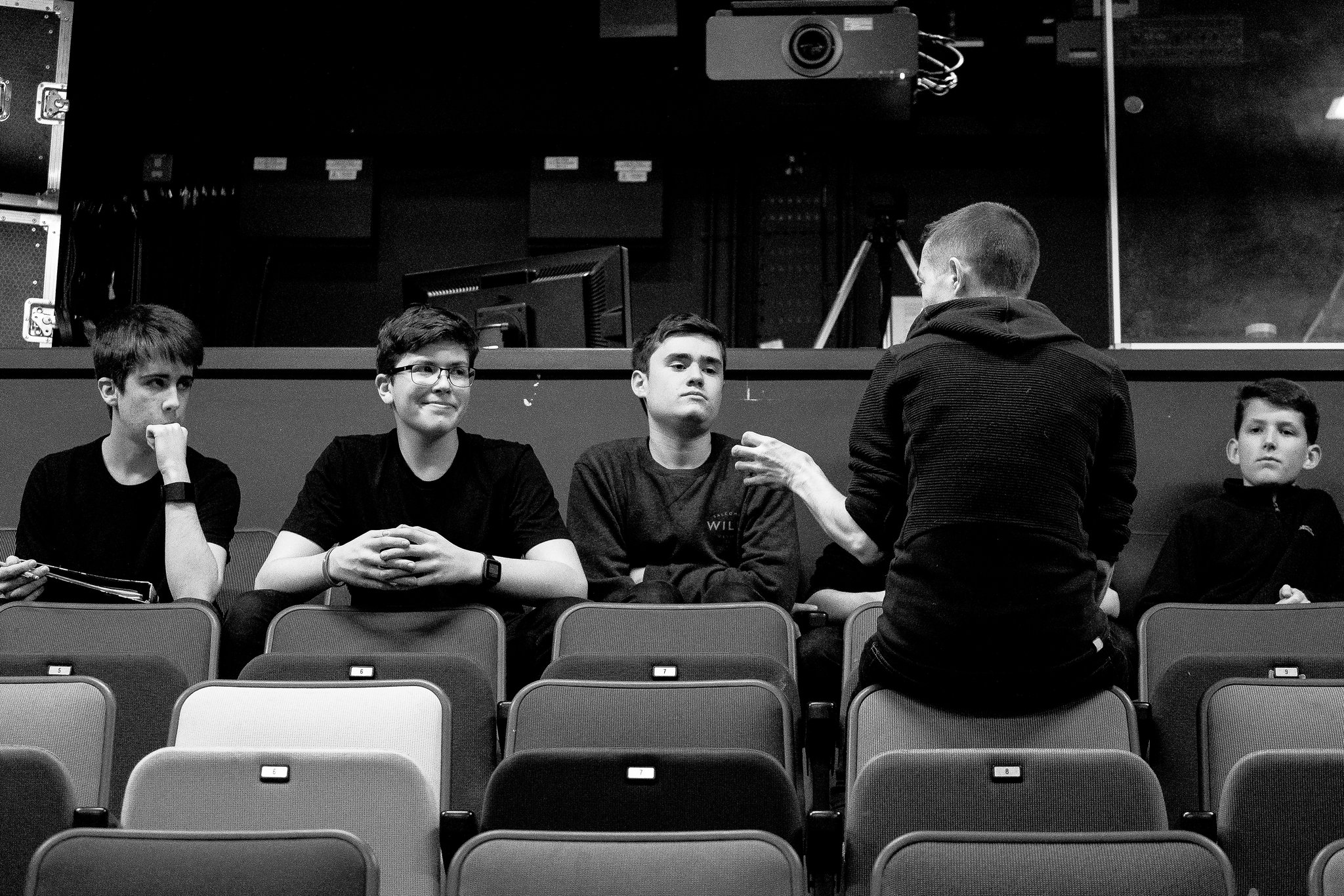
Just as the verbal, physical and visual texts of performance continually change – radically in devising, development and rehearsal periods; more subtly in performance – so too the production elements (lighting, sound, video projection, stage-management) are continually in flux. Always, of course, in that pursuit of the utopia of telling the story as completely and effectively as possible, but deeply affected by the skills, expertise, motivations and moods of individuals and the environment within which it’s happening. Technical elements and stage-management acts are particularly susceptible to changes of environment and the resultant changes in available resources: what can be achieved in the highly controlled environment of a darkened, neutral, black-box theatre space equipped with lighting equipment, a powerful projector and a surround-sound system is dramatically different to what can be achieved in a park or garden exposed to the unpredictability of the elements and natural light levels, with minimal equipment, sometimes even without electrical power. Just as performers must suit their performances to their environment – projecting their voices over background street noise; heightening physical action and facial expressions for a more distant audience; adapting or changing language to suit an audience from another part of the world etc. – so too, the production elements must be adapted, both to suit the theatre-space of that particular performance and to work within its resource limitations. Sometimes there cannot be any theatrical lighting because there’s no power or equipment; projection might be an impossibility in an outdoor, broad-daylight context; it might be too windy or muddy or uneven to build a set.
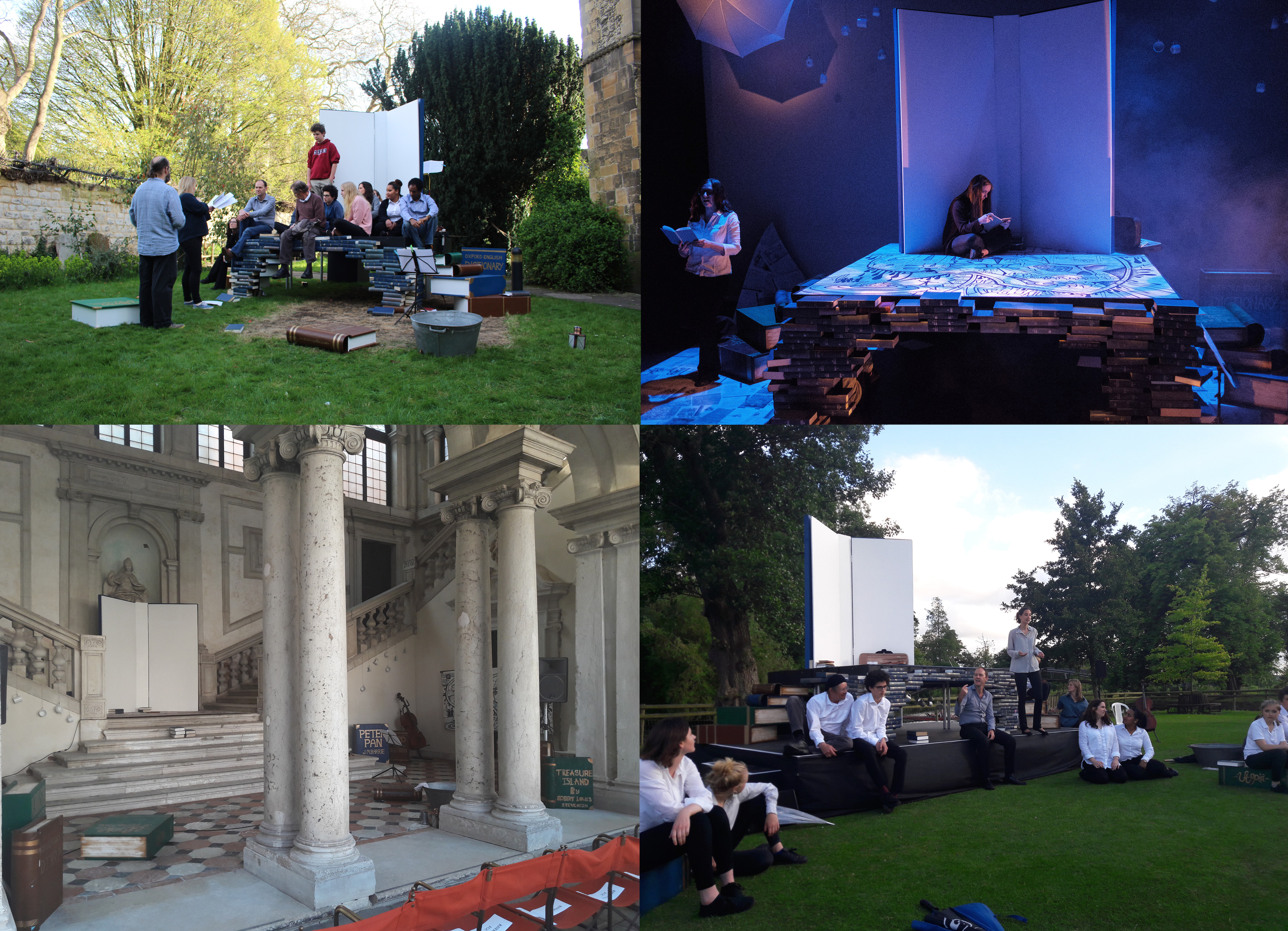
One of the most interesting and challenging aspects of the series of Storming Utopia performances for the Production Team was this continual shifting of environment and the implications on resources doing so produced. We created the piece for a theatre – a neutral space in which we would have pretty much absolute control of what the world looked and felt like to an audience through set and lighting, the possibility of adding to and commenting on the story-telling through projected images/text and limitless possibilities for supporting narrative and building atmosphere through sound effects and music. We also created it with a technical and stage-management team of five young people in mind, which itself lends you the possibility of more (quantity and quality) technical action. On the other hand, you are limited by the size of the stage and the minimal available time to set all these elements up and integrate them into the whole. Different contexts may help or hinder your storytelling in an endless variety of surprising ways…
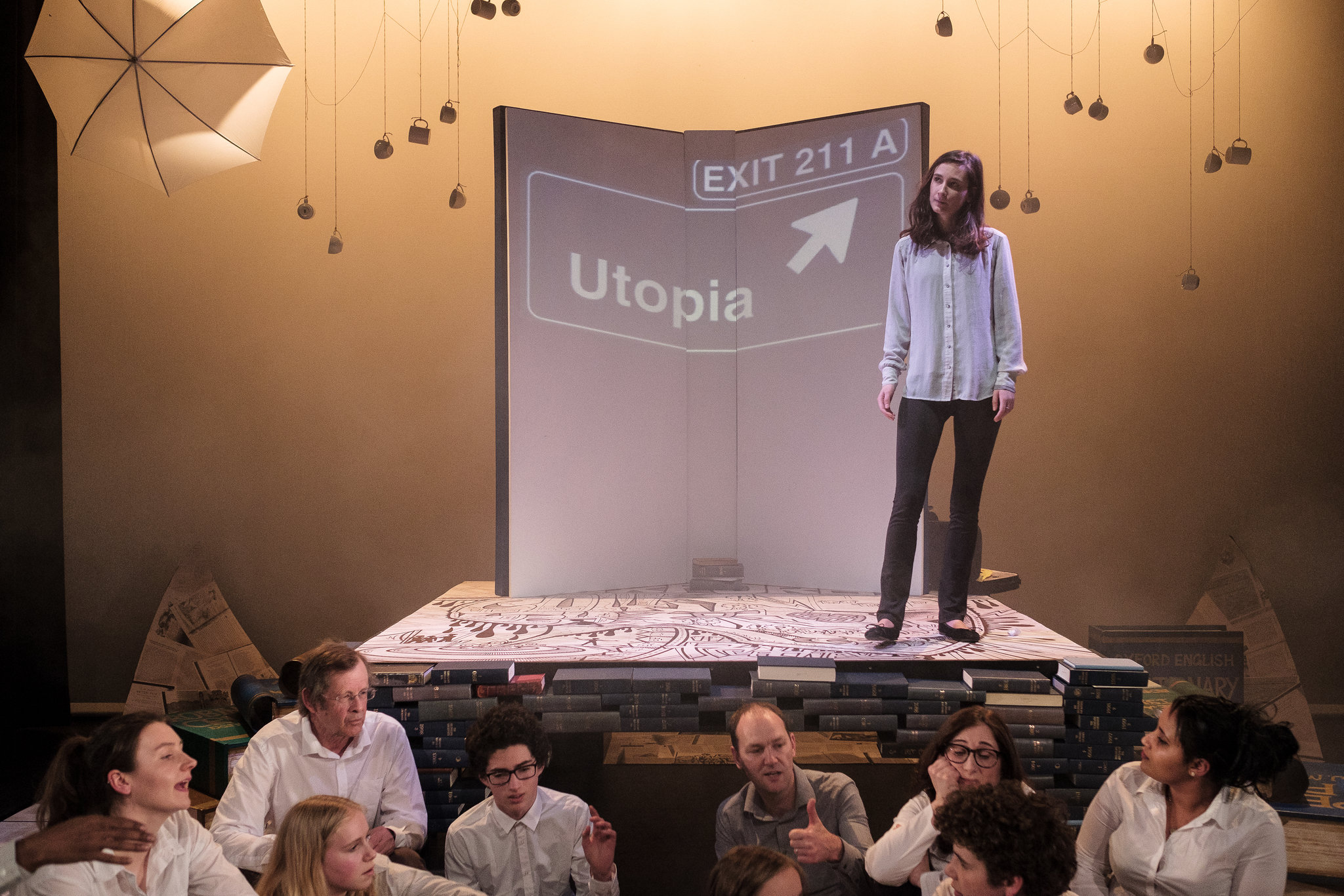
Within both phases of the project we also took the performance out into parks and gardens where almost none of the technical storytelling tools we’d been using were available. Modern technology is ever increasingly portable and the leaps in sound/video programming & control software in recent years means that it’s now very easy to tour your sound design. Sure, it may sound (and feel, in terms of impact) different coming through one tiny portable speaker than it does coming through a theatre’s more complex and substantial arrangement of powerful speakers, but the essence of it – the specific sound actions – can easily be retained. However, the same cannot be said for lighting and projection – these elements are still deeply reliant on the equipment and time available at each venue and sometimes are not possible at all. Of course, if it’s daylight, then lighting and projection become impossibilities anyway and then you’re left with the question, if we perform the play without these elements, are we still telling the same story? Are we building the same world for an audience? Is the narrative still clear? Does it ‘feel’ the same at each moment?
But then, does it need to?
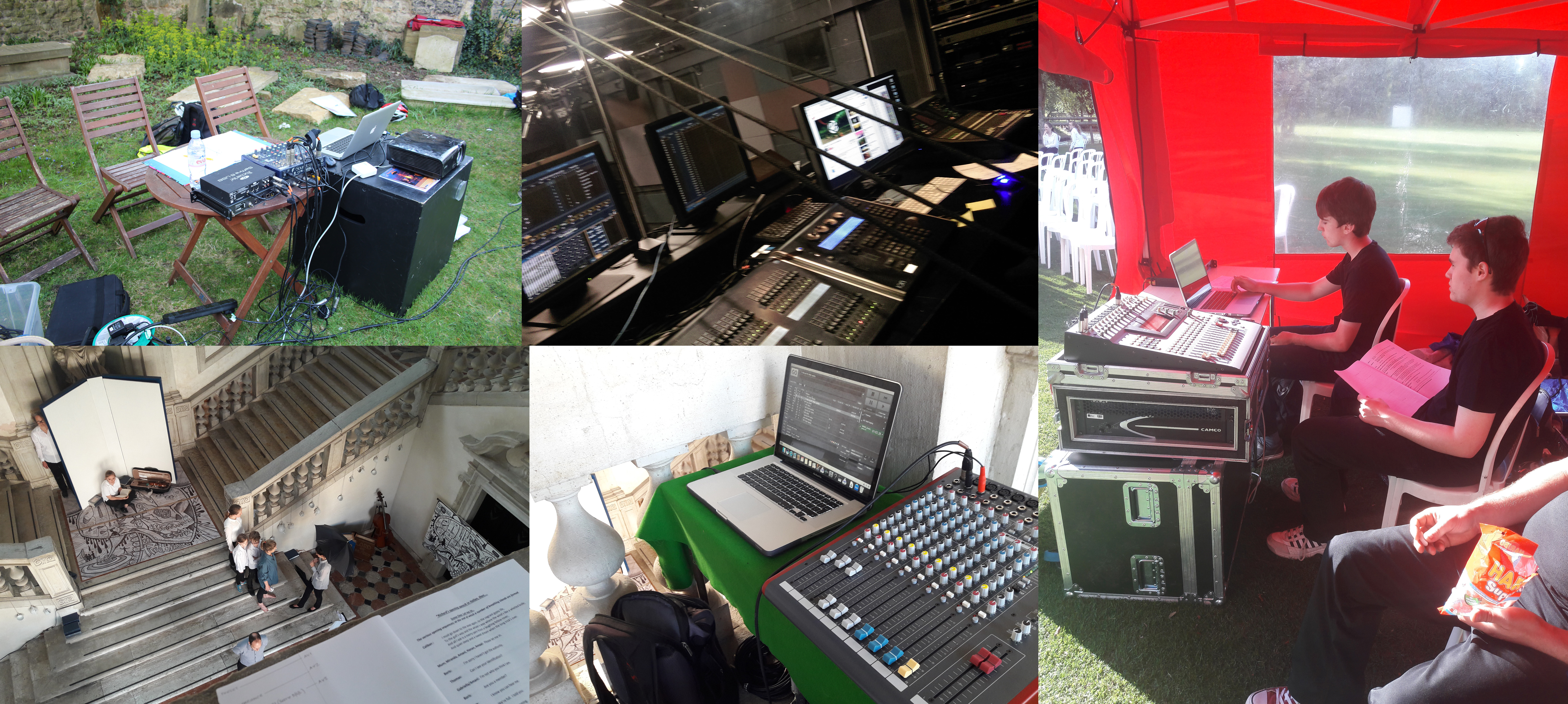
When we took the second-stage version of the play to Venice everything changed again… Could we transport a set to a country on the other side of Europe, onto an island within a city with a transport system built around boats and waterways rather than vans and roads? Could we use a performance space that was, in essence, a staircase rather than a conveniently and conventionally flat square? Could we communicate our technical requirements to technicians speaking another language when technical language is inherently full of specialist jargon that excludes even native-speaking non-specialists from comprehension? What would we lose? What would we gain? Were we drifting away from or compromising our ‘perfect’ vision too far? But would that be a valuable experiment in trying to nail what defines the perfect Storming Utopia anyway?
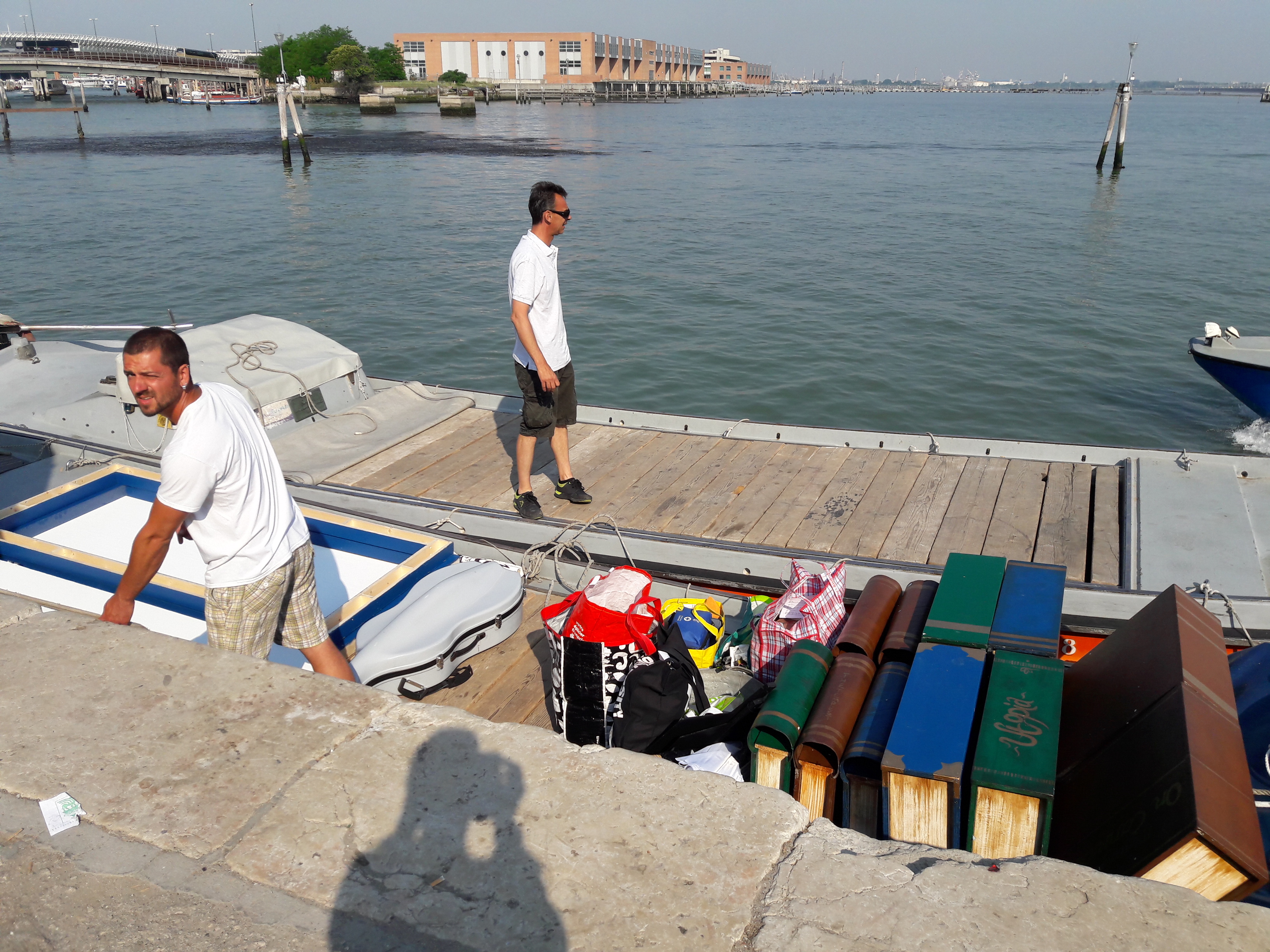
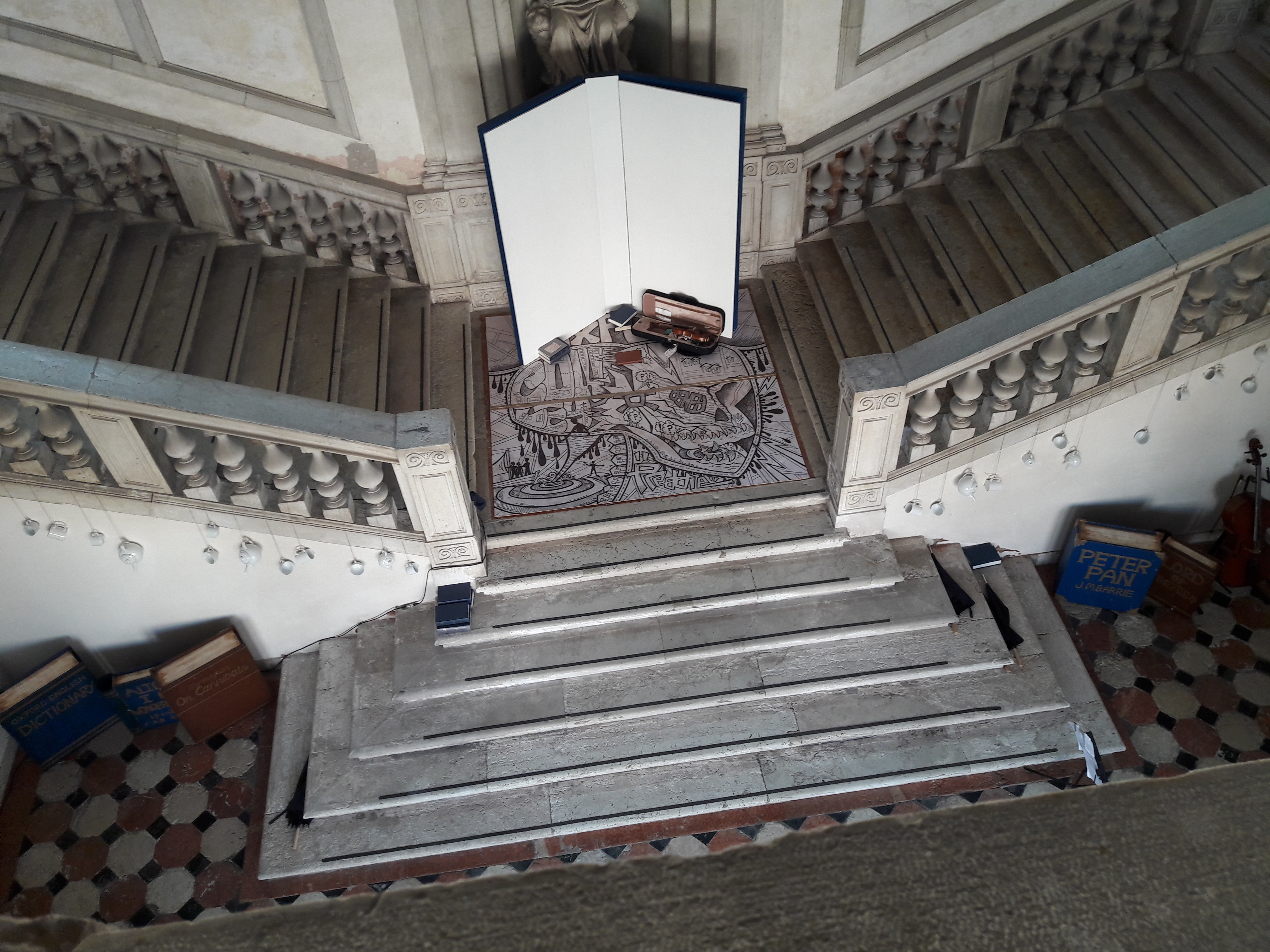
Record
Theatre, by its very nature as a live art with a great many unpredictable forces in play, is difficult to keep a record of. There is no one good way to capture all the many facets of a play in performance. But, just as we may record the spoken words in a script or the visuals of a performance on film, there are ways of documenting and archiving some details of technical elements. One of the most useful, particularly because it changes with each new version of the performance, is the DSM’s script or ‘Prompt Copy’.
The DSM – or Deputy Stage-Manager – can be thought of much like the conductor of an orchestra, overseeing, co-ordinating and timing the actions of individual lighting, sound, projection and stage-management technicians. Much as a conductor works from a musical score – following a rigorously set text but infusing it with their own skill and passion – a DSM creates a version of a play text – the ‘Prompt Copy’ – which notates the specific placement of each technical ‘cue’ or act within the verbal and physical action of the play as a whole. They then ‘call’ these cues from the script they’ve created at each performance to conduct their orchestra of individual technicians. Each lighting change or sound effect or projected image or instance of scenery moving – each technical act -is described as a ‘cue’ and, like music, there is a particular language and style of notation in the Prompt Copy which to an outside eye may seem cryptic or nonsensical. You have to understand the language to be able to interpret the record. And just as the play-text is incomplete, recording only the words without capturing the performance of those words – the actor’s facial expressions, intonation, rhythm of speech, volume, physical actions and body language – so too the DSM’s script records only the technical actions, not the detail of those actions. So LX1 marked in the script captures the fact that the first lighting state (action/change) happened at exactly this moment within the performance, but not what the lighting looked or felt like at that moment. The colours, shapes and shadows are not recorded; the way the performers and set looked under those lights are not recorded; the atmosphere, mood or sense of time and place are missing. All theatre documents are fragments of a whole that cannot ever fully capture it. Good theatre is greater than the sum of its parts, both in creation and in documentation.
But the fragments are fascinating in themselves. Below are extracts of the DSM’s scripts from comparable sections of the play-text in different contexts – Pegasus Theatre, outdoors at Magdalen College School on their playing field as part of a well-resourced arts festival and on the monumental marble Longhena staircase of the Cini Foundation, on the island of San Giorgio Maggiore in Venice, Italy.
 In this first example, an extract from the Prompt Copy of the 1st performance at Pegasus is on the left, a comparable section from the MCS performance is in the centre and a similarly comparable section of the Venice performance is on the right. Looking at the Pegasus extract, you’ll see lighting cues (described as LX) and AV (“audio-visual” or sound and projection) cues marked in the central column. These are written in line with the moment they should happen either in the spoken text (on the right) or a visual cue point/ action (on the left). There are two distinct types of instruction: ones which start with ‘Stand by’ as a prompt for the relevant technicians to prepare to do their next action and ones which end with ‘GO’ as the exact point at which those tasks should be carried out. The Pegasus script is a bit untidy, which suggests, correctly, that it was created from scratch, at speed, during the short technical rehearsal.
In this first example, an extract from the Prompt Copy of the 1st performance at Pegasus is on the left, a comparable section from the MCS performance is in the centre and a similarly comparable section of the Venice performance is on the right. Looking at the Pegasus extract, you’ll see lighting cues (described as LX) and AV (“audio-visual” or sound and projection) cues marked in the central column. These are written in line with the moment they should happen either in the spoken text (on the right) or a visual cue point/ action (on the left). There are two distinct types of instruction: ones which start with ‘Stand by’ as a prompt for the relevant technicians to prepare to do their next action and ones which end with ‘GO’ as the exact point at which those tasks should be carried out. The Pegasus script is a bit untidy, which suggests, correctly, that it was created from scratch, at speed, during the short technical rehearsal.
Looking at how the MCS version differs, the first thing you’ll spot is that all the LX cues have gone. Performing outdoors, during daylight hours, in a field with limited equipment and power, lighting was entirely cut from this version. The script is tidier – someone has had the time to write a new, neat version based on what was learnt when it was first teched. You may also notice, if you look very closely that some of the language of the text has started to change… Odd lines or phrases have been translated into Italian – they’re still there but in a new form.
Finally, looking at the same section in Venice version, the page seems even emptier. Now there’s no ‘Stand-by’ cues at all and the ‘Go’s’ have vanished too. Whilst we had a crew of five technicians at both of the Oxford performances, including a DSM who called these cues for the others, in Venice there was just one single technician performing all roles in one. So instead of speaking the cues for others to follow, the technician simply followed the script themselves and carried out the tasks required at the right moments. Because it’s not being spoken aloud for a listener to hear and respond to, the notation can be simpler. Look again at the text too and you’ll see that more of it has been translated into Italian for our Venice-audience.
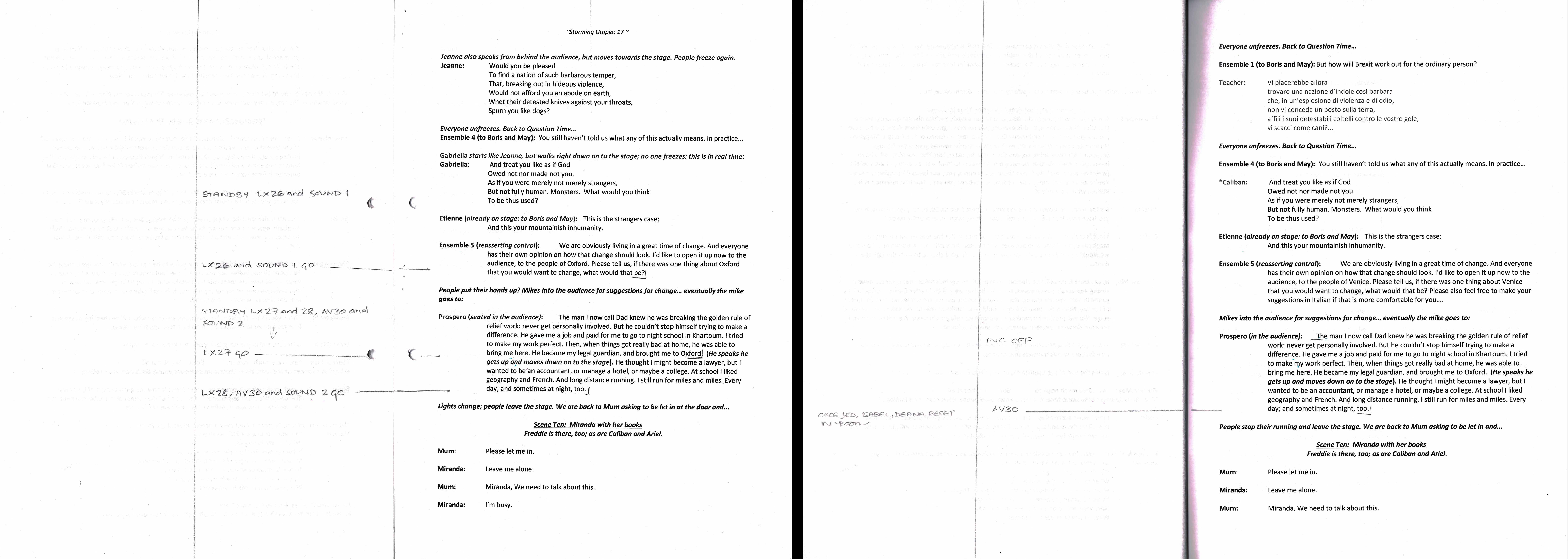
In this example, with the Pegasus performance on the left and the Venice performance on the right, you’ll see again how significantly different each version can be. The Pegasus version has lighting (LX), recorded sound and video projection (AV) and live sound (Sound) cues – complete with ‘stand-bys’ and ‘go’s’ for the operators. In Venice, lighting and projection were both cut entirely and, with no operators, again the ‘standbys’ and ‘go’s’ have gone. ‘Sound 1’ in the Pegasus script refers to a cue to turn a microphone on. This task would have been described separately in the sound operator’s notes. ‘Sound 2’ would have been a cue to turn it off again. But in the Venice version the notation has changed – it would be inconvenient and difficult for a single technician to follow two sets of notes, so instead, the Prompt Copy just summarises these sound cues as ‘Mic on’ or ‘Mic off’. Look closely and you’ll see that the position of those cues have changed too though…technically there is a different series of actions happening.
Additionally you can see a cue that originally was placed at the end of a line of spoken text has changed its cue-point to a visual cue described on the left. Improvements to timings are made by the DSM at every performance and as the performance evolves, so too does the Prompt Copy’s notation of precisely where each cue falls.
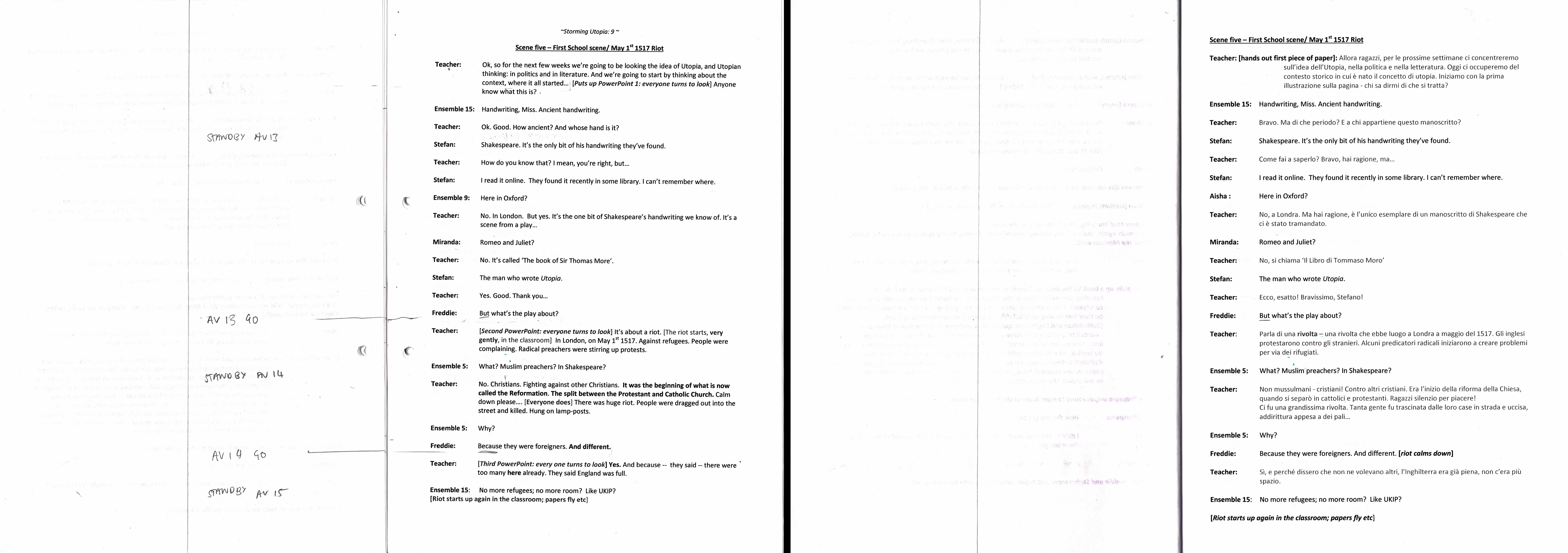
You can see quite dramatically here how significantly a DSM’s script can change. On the left, the Pegasus performance Prompt Copy has a page full of AV cues. On the right, in Venice, not a single cue remains. This is as a result of cutting all use of projected images/ videos because of a performance time within daylight hours and the difficulties of finding and positioning projection equipment in this venue. At Pegasus, the Teacher character used a slide-show of images, like a power-point presentation, to exemplify what she was talking to the class about. In Venice, where this was not possible, you will also see that ALL of the teacher’s text has been translated into Italian to ensure meaning is not doubly lost through lack of both visual storytelling and accessible language.
Below is a selection of other technical and production documents: construction drawings, stage-management props-setting notes etc. Like the appendices to More’s Utopia, these are tantalising fragments that can give you one particular way of looking at the whole. Piecing these fragments together might it be possible to recreate our particular Utopia or does the fact that it was a continually changing creation – never finished, always evolving – with inevitably incomplete records mean that it has been forever lost? We know, after all, that Utopias are ‘no places’ – impossible to create; impossible to preserve. But we keep on trying…
